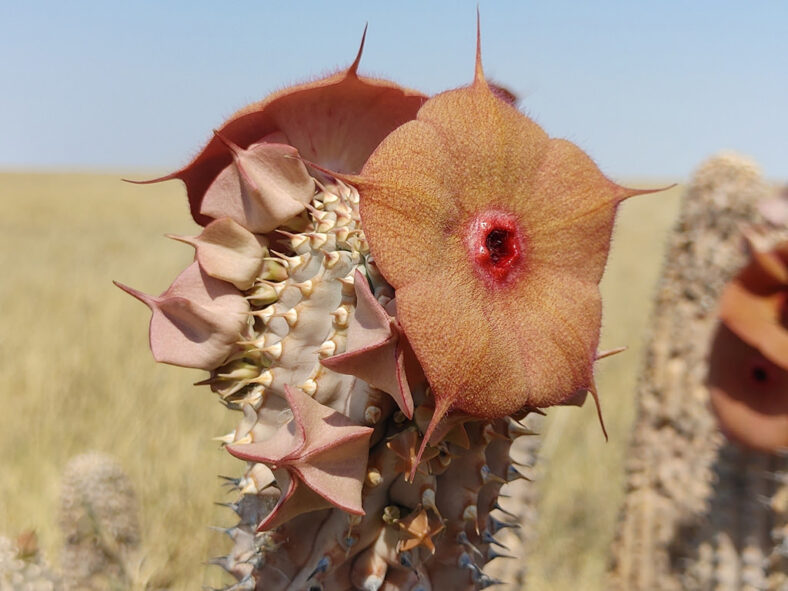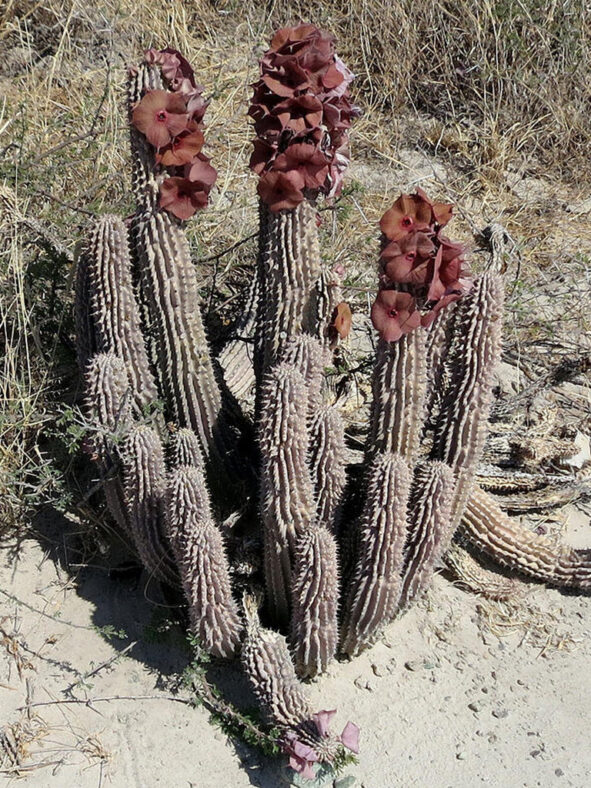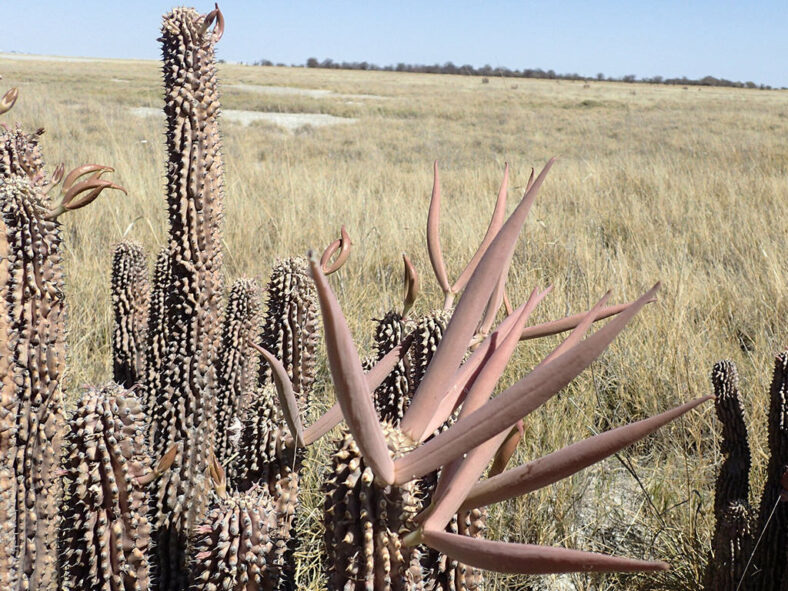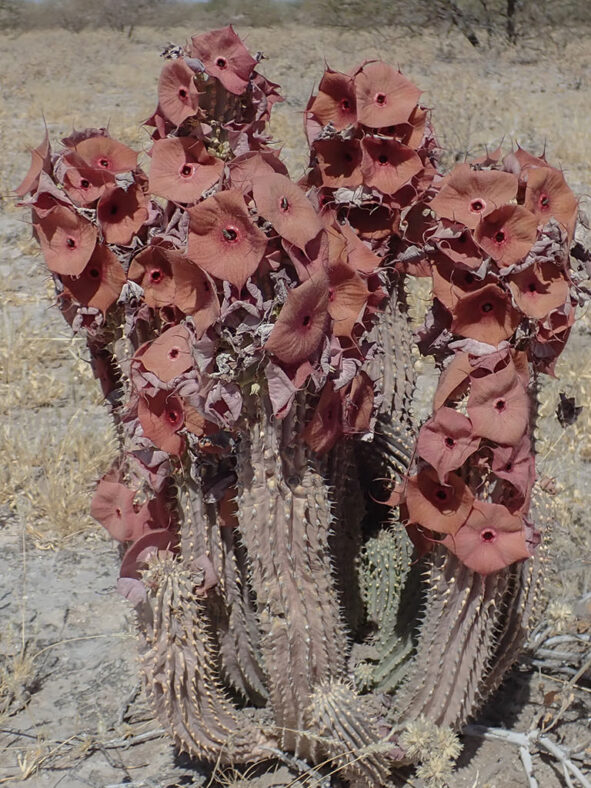Hoodia currorii subsp. lugardii and Hoodia currorii subsp. currorii have a similar appearance, but they differ in their distribution and habitat preferences. Hoodia currorii subsp. lugardii is found further east than any other Hoodia species and typically grows in calcareous soil. In contrast, Hoodia currorii subsp. currorii is mainly found in the coastal Namib desert and extends up to 250 km eastward from the coast.
Scientific Name
Hoodia currorii subsp. lugardii (N.E.Br.) Bruyns
Synonym(s)
Ceropegia currorii subsp. lugardii, Hoodia lugardii
Scientific Classification
Family: Apocynaceae
Subfamily: Asclepiadoideae
Tribe: Ceropegieae
Genus: Hoodia
Etymology
The subspecific epithet "lugardi" (pronounced "loo-GAR-dee-eye") honors Edward James Lugard (1865-1957), a British military officer and plant collector who collected extensively in Botswana.
Origin
Hoodia currorii subsp. lugardii is native to Botswana, Zimbabwe, and northern South Africa. It is found further east than any other Hoodia species and grows on calcareous soil.
Description
Hoodia currorii subsp. lugardii is a robust, many-stemmed succulent shrub with upright to ascending stems that have prominent tubercles fused in the lower half into up to 30 vertical rows. The stems can grow up to 3.3 feet (1 m) long and 3.2 inches (8 cm) in diameter. The color of the stems varies from pale grey-green to brown-green when exposed to intense sunlight. Each tubercle is topped with a sharp spine.
From early spring to mid-summer, Hoodia currorii subsp. lugardii produces large, attractive flowers arranged in clusters near the tip of the stems. The flowers open in succession and can reach a diameter of 7.2 inches (18 cm). The corolla is shallowly cup-shaped, glabrous on the outside, papillate on the inside, displaying colors that range from brick-red to flesh-pink or yellowish-pink, often with darker veins. The corona is deep red-purple or red-brown. The fruits are pairs of fusiform, horn-like follicles that can be pink to green follicles and can grow up to 8.8 inches (22 cm) long.

How to Grow and Care for Hoodia currorii subsp. lugardii
Light: Hoodia currorii subsp. lugardii prefers full sun but will benefit from light shade during the hottest summer days. Indoors, place the plant near the brightest window of your home because it will stretch if it does not receive enough sunlight. Avoid abruptly moving a plant adapted to lower light levels to full sun to prevent sunburn.
Soil: Use commercial potting soil mix for succulents or prepare your own with 50% to 70% mineral grit, such as coarse sand, pumice, or perlite.
Temperature: The plant thrives in warm outdoor environments with low to moderate humidity. It does not like winter cold and should remain fairly dry and warm during its dormancy. Hoodia currorii subsp. lugardii grows best in USDA Plant Hardiness Zones 10a to 11b, with average minimum winter temperatures ranging from 30°F to 50°F (-1.1°C to 10°C).
Watering: It has typical watering needs for a succulent. From spring to fall, during its growing season, water the plant thoroughly and allow the soil to dry between waterings. When it goes dormant in winter, it needs almost no water, about once a month.
Fertilizing: Fertilizing is a good idea to keep the plant healthy and thriving. Use a water-soluble fertilizer diluted to half the recommended strength, but only during the growing season.
Repotting: Repot Hoodia currorii subsp. lugardii in spring, just before the growing season. It has shallow roots and does not require too much soil to grow. Always pick a container with drainage holes.
Propagation: The best way to propagate this succulent is by stem cuttings. To ensure good rooting, take cuttings during the growing season. The plant is also easy to start from seeds in spring.
Learn more at How to Grow and Care for Stapeliads.
Toxicity of Hoodia currorii subsp. lugardii
Hoodia currorii subsp. lugardii is non-toxic and safe to grow around kids and pets.
Links
- Back to genus Hoodia
- Succupedia: Browse succulents by Scientific Name, Common Name, Genus, Family, USDA Hardiness Zone, Origin, or cacti by Genus
Photo Gallery
Click on a photo to see a larger version.


